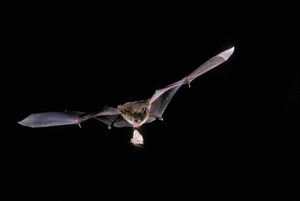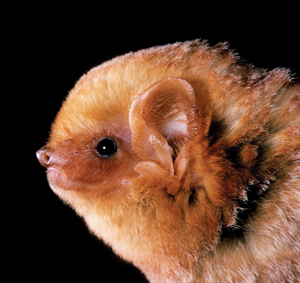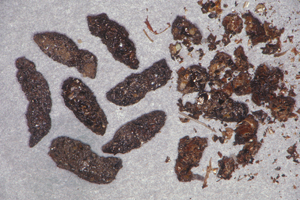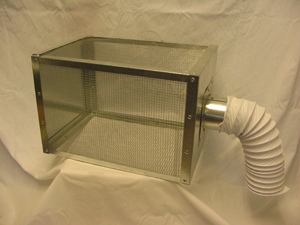G1667
Bats in and Around Structures
This NebGuide describes common bats and their habitats in Nebraska. Recommendations for their exclusion and removal from homes and structures also are discussed.
Dennis M. Ferraro, Extension Educator
Lisa A. Pennisi, Extension Specialist, Natural Resources
Scott E. Hygnstrom, Extension Specialist - Wildlife Damage
Stephen M. Vantassel, Extension Project Coordinator - Wildlife Damage
- Bat Facts
- Ecological and Economic Importance
- Bat Signs
- Preventing Entry / Exclusion
- One-way Doors
- Live Bat Trapping
- Individual Bat Removal
- Frightening
- Repellents
- Toxicants
- Diseases
- Bat Houses
Bats are misunderstood creatures. They are depicted as scary animals in vampire movies and as creepy symbols of Halloween. These depictions and the many myths about these nocturnal creatures make many people fear that bats will attack them. But bats are not aggressive and become less frightening when we take time to learn about them.
Bat Facts
Bats are not rodents but are mammals in the order Chiroptera, meaning hand-wing. Because bats are the only mammal capable of true flight, bat wings are elongated finger bones covered with a thin layer of skin. Over 1200 species of bats exist worldwide with diets ranging from fruit to nectar to insects. All of the bats found in Nebraska are insectivores, feeding solely on flying insects such as mosquitoes and moths. Insectivorous bats have small needle-like teeth that crush insect exoskeletons. They do not chew wood, caulk, or structural materials. Bats are nocturnal and seldom are seen in daylight unless disturbed. Bats have good vision yet rely on hearing, using echolocation or “sonar” to navigate and hunt in the dark of night. They catch flying insects in the air with their mouths or scoop them up with their tails while flying. One little brown bat can eat 600 to 1200 mosquito-sized insects every hour. Nebraskans should welcome bats as they devour more mosquitoes than any bug zapper. Bats drink while in flight by swooping over sources of standing water, including swimming pools.
Thirteen species of bats occur in Nebraska. Most, however, are uncommon and rarely found near structures. The big brown bat (Eptesicus fuscus, Figure 1) lives throughout the state and is the most frequently encountered bat around structures. As the name suggests, this bat has dark brown fur on its back, pale brown fur on the underside, and black skin exposed on the nose, ears, and wings. It is 4 to 5 inches long from nose to tail and weighs ½ to ¾ of an ounce. With a wingspan of 12 to 16 inches, big browns appear larger in flight (Figure 2).
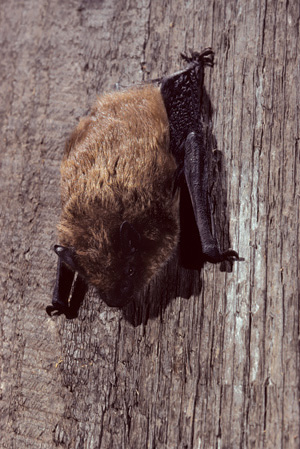 |
|
|||
| Figure 1. Big brown bat, Eptesicus fuscus. Photo by Merlin D. Tuttle, Bat Conservation International, Inc. |
The little brown bat (Myotis lucifugus) occurs in the eastern third of Nebraska. This bat is 2½ to 4 inches long, weighs ⅕ to ½ an ounce or about as much as three to five pennies, and is glossy dark brown. It looks very similar to the big brown bat but is smaller. The little brown bat is highly susceptible to white-nose syndrome, a fungal disease that is causing the deaths of significant numbers of bats in the eastern half of the United States and is spreading westward across the U.S. To learn more, visit http://www.fws.gov/WhiteNoseSyndrome/about.html.
|
The red bat (Lasiurus borealis, Figure 3) resides mainly in the bark or foliage of trees, including trees in residential landscapes. The red bat can be seen at dusk flying an elliptical pattern near trees while catching insects. Red bats have reddish-brown to rust-colored fur on top with a paler red underside and cream or off-white patches on each shoulder. Smaller than the big brown bat, reds weigh ⅕ to ½ ounce and can be up to 4½ inches long.
Nebraska’s bats mate in early fall but delay fertilization, meaning females hold sperm in utero until late winter or early spring, allowing them to delay pregnancy until the spring, when insects are abundant. Young are born 8 to 12 weeks later and usually stay in maternal roosts until late summer. All of Nebraska’s bats give birth just once per year and most, including big brown and little brown bats, have just one young. Red bats, however, can have four young at once and often have two to three.
Bats typically leave roosts at dusk to hunt and may return several times during the night. Under natural conditions, bats normally live under loose bark, among foliage, or in hollow trees, caves, quarries, and cracks of rocky ledges. In urban areas, however, crevice-dwelling bats frequently reside in attics or areas behind shutters, downspouts, seams of bridges, and even in storm sewers. Some species of bats are colonial, such as big brown bats that live in groups of 50 to 200 and little brown bats that live in maternity colonies of up to 300,000 bats; hence, they are particularly vulnerable to white-nose syndrome.
As temperatures cool and insects become less available, bats migrate to suitable hibernation sites. Migration is not necessarily southward. Some species of bats in Nebraska actually move north and east to the Ohio Valley to hibernate. Bats use caves and structures capable of maintaining the constant temperature needed for hibernation. The exact temperature needed for hibernation varies by species. If hibernating bats are disturbed, causing them to wake too often, they will not have enough fat reserves to survive through winter and ultimately will starve. Big brown bats hibernate in Nebraska and frequently choose human structures for their hibernacula.
Ecological and Economic Importance
Many species of bats play a vital role in the environment. In Nebraska, bats assist in the control of insects. Each bat consumes 25 percent to 125 percent of its body weight in insects each night. A colony of 150 big brown bats can consume enough cucumber beetles (Diabrotica spp.) in a single season to prevent the hatching of 33 million more! Nebraska’s big brown bats eat other agricultural pests such as leafhoppers, June beetles, and stinkbugs. Studies show that in some areas bats can reduce agricultural insect pests, such as corn earworms (Heliothis zea) and tobacco budworms (Heliothis virescens), and decrease the need for applications of agricultural insecticides, saving farmers millions of dollars. Just imagine what these creatures could do for your garden. Unfortunately, many bats worldwide are endangered or threatened, and in the U.S., 50 percent of the bat species are in decline.
Bat guano has been prized for years by gardeners as a nitrogen-rich organic fertilizer. Guano typically includes 10 percent nitrogen, 3 percent phosphorous, and 1 percent potassium. Bat guano, like bird guano, can grow a fungus in hot, humid enclosed environments. This fungus can become airborne and cause histoplasmosis in humans. If you decide to use guano as a fertilizer, apply it in open outdoor areas and avoid creating and breathing dust. Handle guano only in well-ventilated areas and in small quantities at a time. Dust masks are advisable when handling guano, particularly for those with allergies to chitineous particles (e.g., shrimp, crab, etc.).
Bat Signs
|
Droppings are the most common sign that bats are present. Individual droppings are small (⅛- to ¼-inch long), black, and dotted with speckles (Figure 4). The speckles are fragments of the exoskeletons of insects. With magnification (10X), you may be able to identify the insects by their remains. Droppings often are found on attic and porch floors and under eves and shutters. Droppings and urine accumulate beneath a colony of bats over time, leading to staining and a rather pungent odor in enclosed spaces.
Bats can enter through openings as small as ⅜ inch in diameter. When bats are residing in a structure, they will use the same opening(s) every evening. The presence of smudges, caused by oil and dirt rubbing off of the bat’s fur, indicates that an animal has used the opening. Look for rub marks at entry points near eaves, vents, chimneys, cracks, and other openings as well as bat droppings. Occasionally the squeaking and scratching of individual bats can be heard in a wall void, ceiling, and other spaces.
Preventing Entry / Exclusion
Conflicts with bats fall into three categories: exterior, interior, and domiciled. Exterior problems occur when bats are resting inside unscreened porches, behind shutters, or flying around lights. To address exterior problems: direct bright light at the resting site to encourage bats to abandon the location; remove or secure shutters to prevent bats roosting behind them; and turn off exterior lights to prevent flying insects from gathering. If light is needed for safety, use a yellow “bug light” bulb to reduce the number of insects attracted to the area, and consider adding a motion sensor to reduce the duration of illumination.
Interior conflicts occur when a bat is found in the living space of your home. Bats occasionally find their way into houses in the early evening when seeking shelter or feeding on insects attracted by doorway lights. An open chimney or furnace vent can be an entry point for bats and other animals that may roost in the chimney or gain access to the interior of the structure. Install an approved stainless-steel chimney cap with ⅜-inch wire mesh to reduce access by bats.
Domiciled bats are those actively roosting inside the structure but not in the living space. People frequently wonder if the discovery of a bat means bats are living in their home. Bats likely are resident if they are discovered during the winter, or when two or more isolated bats are found in the living space between March and October. Homeowners frequently encounter bats in July, when the young move around but are not strong enough to forage as adults. Once they begin flying, young bats also are more likely to make mistakes, like inadvertently flying inside a window or door.
Prevention is the best way to avoid having bats in your home. Fortunately, bats cannot create their own entry holes. Therefore, it is important to seal all cracks, plug all holes, and use good screens and tight-fitting doors prior to having a problem. Hardware cloth (¼-inch or smaller mesh), caulk, sealant, and weatherproof foam strips are excellent materials for excluding bats during exclusion season. Foam insulation will degrade under UV light and is not recommended.
If, however, bats are residing in the attic or a hidden area in the structure, you can exclude them after Aug. 1 as the young will be mature enough to leave the roost. Exclusion can be performed using the following method:
- Locate all exit and entry points by standing outside of the structure at dusk on clear summer evenings and looking for bats that are exiting the building to go foraging at night.
- Secure all unused openings with ¼-inch screening, caulk, or sealant.
- Cover all exit or entry points by hanging 1-foot strips of flexible ¼-inch netting to permit bats to exit but not reenter.
- Allow at least one week to pass, then seal and patch all entry points.
- Do not install one-way doors or seal exit/entry points during June through July when young bats are likely to be in the roost (June through July — let them fly!); wait until Aug. 1.
Do not exclude bats when young are present, as young bats, abandoned or sealed in a structure, will move about the structure looking for a way out, and eventually will starve and die. Dead bats in a structure will decay and may cause an odor problem.
One-way Doors
Exclusion devices are available in two basic designs that allow bats to leave structures in the evening but not regain access. Each design has its advantages but both are equally effective in excluding bats. Tube versions consist of a 2-inch wide cylinder placed over holes (Figure 5a). The tube should be at least 3 inches long. Position tubes at a downward angle. Nylon mosquito netting is useful for excluding bats from vents or long crevices. Cut the netting so it is 4 inches wider than the gap and long enough to extend at least 1 foot below the exit. Secure the netting above and on the two sides, leaving only the bottom open (Figure 5b). Make sure the netting is not flush against the crevice because this will prevent the bats from exiting. Bowing the netting or adding a ½-inch strip of wood above the crevice will ensure a large enough gap for bats to exit. To prevent possible transmission of the fungus that causes white-nose syndrome, submerge tubes in 122°F water for at least 15 minutes before reuse. Do not reuse netting.
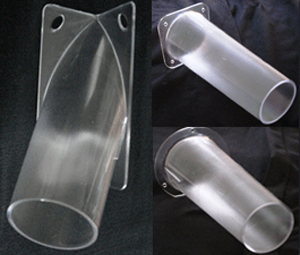 |
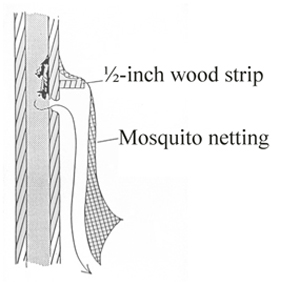 |
|
| Figure 5a. Pro-cone® bat excluder tube. Photo courtesy of Bat Cone. | Figure 5b. Side view of netting used to exclude bats. Secure the top and sides, but leave the bottom open to allow bats to leave. UNL drawing. |
Live Bat Trapping
|
Large colonies of bats roosting in structures may be trapped when an outbreak of rabies is suspected or if permits have been granted for translocation. A permit from the Nebraska Game and Parks Commission is required to transport and release wildlife beyond 100 yards. Several bats can be captured using one-way door devices that have a holding or collection bag attached or by building “roost traps.”
Secure a 10-inch-long cloth sleeve or funnel around the bats’ exit point and hang it on the outside of the structure. Attach a 6-inch length of 2-inch diameter aluminum pipe to the bottom of the cloth sleeve. To the other end of the pipe, secure a cloth or plastic sack with a strong elastic band or duct tape. This device also can be used to capture a lone bat as shown in Figure 6.
Cage traps consist of a tube, check valve, and holding chamber. Tubes are placed over the openings used by bats. Holding chambers are secured to the structure. After leaving the structure, the bats are captured by the trap, unable to return to the den site. The trap is covered and the collected bats can be removed. Only professional wildlife control operators should handle, remove, and transport live-captured bats. Bat traps are commercially available for $100 to $200 (Figure 7).
To prevent possible spread of the fungus that causes white-nose syndrome, submerge traps in 122°F water for at least 15 minutes before reuse.
Individual Bat Removal
If a single bat has entered a home or structure, the following procedure can be used:
- Determine if rabies exposure is possible (see Bat Rabies section), and if not,
- Open all exterior doors and windows in the room(s) where the bat was observed.
- Shut all doors leading to adjacent rooms to confine the bat in the areas where entries are opened.
- Leave the lights on and stand motionless next to a wall or in a hallway leading to the room.
- Patiently wait as the bat swoops around the room trying to find a way to escape (contrary to popular belief, bats are not attracted to people’s hair) and flies out of the room on its own. Do not wave at or herd the bat. Witness the bat leaving the home.
If the bat is at rest on a wall (usually behind curtains or window blinds):
- Put on a pair of thick leather gloves.
- Get a large-mouthed glass, cup, or plastic container.
- Approach the bat slowly from one side and place the container over the bat.
- Slide a piece of cardboard or stiff paper between the container and wall, securing the bat inside the container.
- Determine if the bat should be tested for rabies according to the rabies protocol. If not,
- Carry the bat in the container with the paper lid outdoors.
- Place the container with lid against the side of a tree at least 4 feet above the ground or other elevated location outdoors (most bats need to fall to gain lift and fly), and
- Carefully slide the paper out from between container and tree, then slowly lift the container. The bat may not fly immediately, but it will be safe from predators until it flies away.
Frightening
Bats roosting under overhangs may be moved by shining bright lights at the roost site. Ultrasound devices have not been proven to be effective in deterring bats.
Repellents
The best way to exclude and repel bats is using the exclusion and prevention methods already described. Several commercial products are available to repel bats. The effectiveness of these products, however, is questionable, and they have not been tested on bats in Nebraska. Do not use mothballs to repel bats. The two ingredients used to manufacture mothballs, naphthalene and para-dichlorobenzene, are considered possible human carcinogens by the Environmental Protection Agency (EPA).
Toxicants
No toxicants are registered for bats in Nebraska or the United States. Since bats feed exclusively on live insects, it is unlikely that any toxic bait would entice bats to eat it. Tracking powder is highly toxic; therefore, trapping is advised. But in extreme cases, such as when public health is threatened by rabies, the Centers for Disease Control (CDC) and the EPA may provide special permits to use toxic tracking powder to control bats.
Diseases
Bats are associated with rabies and histoplasmosis, two significant diseases that can be transmitted to humans. While these diseases are significant, they are easily avoided and should not be used as an excuse to kill bats.
RabiesRabies is a viral disease that affects the nervous system. While rabies is endemic to bats, less than ½ of 1 percent of bats have rabies and only one to two human deaths per year in the U.S. have been associated with the bat-strain of rabies. The human death rate is low because bats avoid human contact, and the disease can be prevented when exposure to rabies is suspected.
Bats infected with rabies do not become aggressive. Infected bats are more likely to be found on the ground or inside structures. Never pick up a bat without wearing thick leather gloves. Like most wildlife, bats will bite in self-defense. While bat bites typically hurt, bats’ teeth are so small that there may not be any evidence of a bite. It is possible for sound sleepers not to realize they were bitten. Therefore, Nebraska has adopted protocols for handling potential bat-human exposures.
Assume a person was bitten if any of the following conditions exist:
- He or she awakes to find a bat in the room.
- A bat was found in the room with someone unable to communicate well (e.g., a child, or a person who is intoxicated, otherwise mentally impaired, or sleeping), or
- A bat made contact with a person.
In these situations, it is important to capture the bat using thick gloves, towels, or a box that can be placed over the bat. Refrain from using swatting devices. Take care not to damage the bat’s head during capture. Do not release the bat. Contact local health officials or Nebraska Health and Human Services at 402-471-2937 for additional information on rabies treatment and testing. If the bat is not found within a couple of hours, it is unlikely that it will be found. If the bat is not available for testing, consult health professionals about needed treatment.
Histoplasmosis
Histoplasmosis is a fungal disease that is associated with guano from bats. The fungus grows best in dark and humid areas with large accumulations of guano. Inhalation of fungal spores is the primary mode of infection. Spores become airborne when guano is disturbed. Do not remove large guano deposits without appropriate training and protection. To learn more, read the online document published by the Department of Health and Human Services, Histoplasmosis — Protecting Workers at Risk (Publication number 2005-109).
Bat Houses
You may be able to take advantage of the appetite of bats for insects to reduce insect pests in your area. Consider providing a home for bats by installing bat houses. While several designs are available, bat house specifications vary for each species, especially in terms of crevice width. Bat houses also need to be placed and supported in ways that encourage habitation. Often, people lack success with bat houses because they purchase the wrong type or hang them incorrectly. For more information on building, purchasing, or hanging bat houses, refer to the NebGuide G1575, Bat House Construction and Installation at http://www.ianrpubs.unl.edu/sendIt/g1575.pdf.
Bats are an important component of Nebraska’s environment. While the ultimate impact of white-nose syndrome is not yet apparent, it may be devastating to populations of these very beneficial and important creatures. Nebraskans must endeavor to ensure that our management of human-bat conflicts is as considerate as possible to ensure the continued abundance of bats in our state.
This publication has been peer reviewed.
| Disclaimer: Reference to commercial products or trade names is made with the understanding that no discrimination is intended of those not mentioned and no endorsement by University of Nebraska–Lincoln Extension is implied for those mentioned. |
Visit the University of Nebraska–Lincoln Extension Publications website for more publications.
Index: Wildlife Management
Wildlife Damage Control
2007, Revised November 2012
